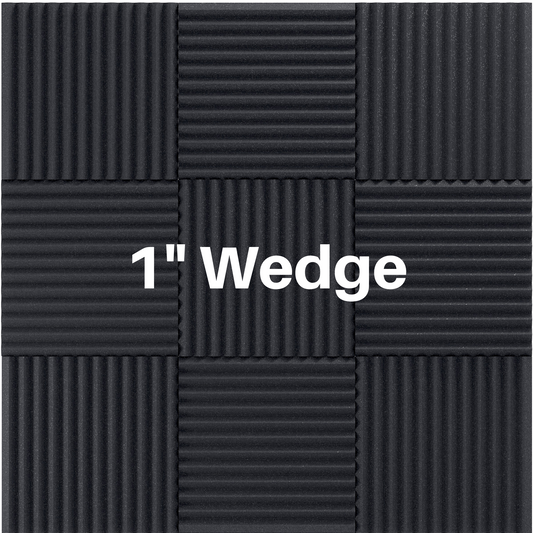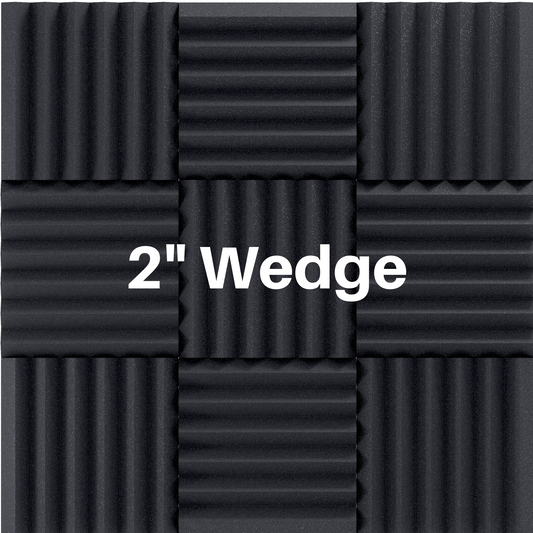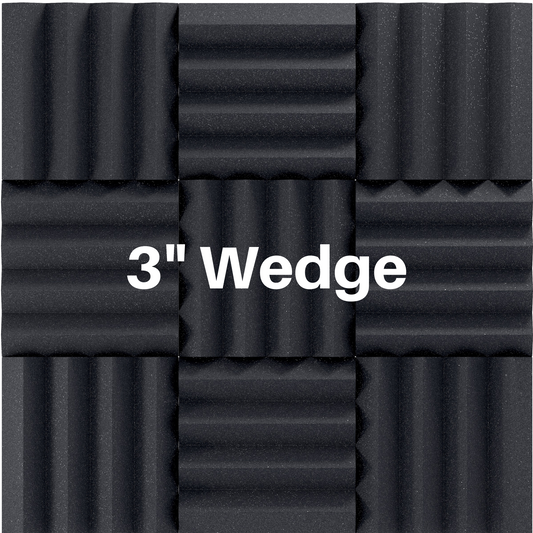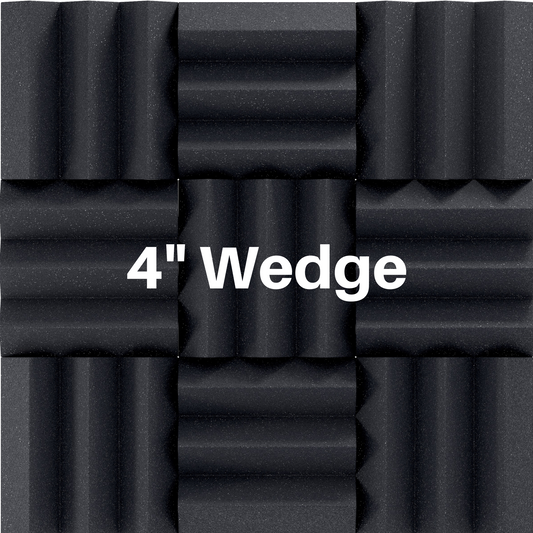The Ultimate Guide to Choosing the Right Acoustic Foam for Your Space
Share
Importance Of Acoustic Treatment
In today's fast-paced world, the spaces we inhabit are filled with various sources of noise, from bustling streets to electronic devices. This increasing noise pollution not only disrupts our peace but also affects the quality of sound within enclosed environments. Whether you're a music enthusiast aiming to create a pristine recording space, a professional seeking a quiet office environment, or a homeowner aiming to improve the acoustics of your home theater, the importance of acoustic treatment cannot be overstated.
Acoustic treatment involves manipulating the way sound behaves within a room to create an optimal listening or working environment. It not only enhances the overall sound quality but also reduces unwanted echoes, reflections, and other acoustic anomalies that can negatively impact your experience.
Whether you're a musician, content creator, or simply someone who values tranquility, investing in acoustic treatment can significantly transform your world!
Role Of Acoustic Foam
Acoustic foam is a versatile and effective solution designed to absorb sound waves and reduce their reflection. Doing this diminishes the presence of unwanted echoes and reverberations. These panels are engineered with unique patterns and structures that effectively disperse sound energy, ultimately leading to a more balanced and controlled acoustic environment.
Our acoustic foam formulas have been tested for optimal absorption. You may think that the most dense foam is the best at sound absorption. However, we have tested many formulas and found a specific density and open cell structure that absorbs sound optimally.
Acoustic foam is not a one-size-fits-all solution. It comes in various thicknesses and configurations to address specific acoustic challenges. Understanding these differences and selecting the right type of foam for your space is important for achieving the desired acoustic results.
Understanding Acoustic Foam
What is acoustic foam?
Acoustic foam, also known as sound-absorbing foam or soundproof foam, is a specialized material designed to control and improve the acoustics of a space by absorbing sound waves.
It is commonly used in various settings such as recording studios, home theaters, offices, and residential spaces to reduce echoes, reflections, and reverberations, resulting in a more balanced and controlled sound environment.
Acoustic foam is usually made from open-cell polyurethane foam, which possesses excellent sound-absorbing properties. Another popular style of acoustic foam is melamine acoustic foam.
How does acoustic foam work?
When sound waves hit the surface of the foam, they pass through the open-cell structure of the foam material. This structure converts the sound energy into heat energy as the air particles within the foam vibrate and dissipate the sound energy.
This conversion process reduces the amount of sound energy that gets reflected back into the room, leading to a reduction in unwanted echoes and reverberations.

Types Of Acoustic Foam
- Wedge foam
- Pyramid foam
- Egg crate foam
- Bass traps
- White foam
Wedge Foam
Wedge foam panels feature a distinctive wedge shape with slanted sides. These panels are effective at absorbing a wide range of frequencies, making them suitable for various applications.
Pyramid Foam
Pyramid foam panels have a pyramid-shaped design that provides slight less absorption than wedge foam simply because there is less mass in the panel. Pyramid foam is commonly used in recording studios and home theaters, or anywhere that needs mid to high frequency absorption.
Egg Crate Foam
Egg crate foam is recognizable by its textured surface resembling an egg carton. This foam performs similarly to wedge or pyramid, but has a slightly different aesthetic. We use a convoluting machine rather than a CNC machine for this foam.
Bass Traps
Bass traps are specifically designed to target low-frequency sound issues. These foam pieces are thicker than standard foam and are strategically placed in corners where low-frequency energy tends to accumulate.
Assessing Your Acoustic Needs
Identifying The Purpose Of Your Space
Before embarking on your acoustic treatment journey, it's crucial to clearly define the purpose of the space you're working with. Different spaces have unique acoustic requirements based on their function.
Whether you're setting up a home recording studio, a cozy home theater, a productive office, or any other environment, understanding the primary activities that will take place within the space will guide your acoustic treatment decisions.
Common acoustic issues to address
- Reflections
- Reverberation
- Standing waves
- Low-frequency issues
Reflections
Reflections occur when sound waves bounce off hard surfaces like walls, floors, and ceilings, creating unwanted echoes and interfering with sound clarity. Assess your space for prominent reflective surfaces and areas where sound waves are likely to bounce.
Reverberation
Reverberation refers to the prolonged persistence of sound in a room due to multiple reflections. Excessive reverberation can muddy sound quality and make speech or music less intelligible. Identify spaces where reverberation is particularly problematic, such as large empty rooms or spaces with bare walls.
Standing Waves
Standing waves are the result of sound waves bouncing back and forth between parallel surfaces, creating areas of strong and weak sound intensity, known as "nodes" and "anti-nodes." These waves can cause uneven frequency response and affect the accuracy of audio playback.
If your room has parallel flat surfaces (most rooms do) then standing waves are something that are going to occur. These are less problematic for rooms like offices or restaurants, and are more problematic in studios and home theaters.
Low-Frequency Issues
Low-frequency sound waves are challenging to control due to their longer wavelengths. These waves can cause "boomy" or "muddy" bass response in rooms. If your room has a lot of low frequency noise being produced like a concert hall, studio, or home theater, then you will need to address it with something like bass traps.
By identifying the purpose of your space and recognizing these common acoustic issues, you'll be better equipped to choose the right acoustic foam and treatment solutions that effectively address the specific challenges present in your environment. This understanding will set the foundation for creating an acoustically optimized space that enhances your listening, recording, or work experience.
Factors to Consider When Choosing Acoustic Foam
Material Quality
The quality of the acoustic foam material greatly influences its performance and longevity. Opt for foam that is made from high-quality open-cell polyurethane or melamine foam. Inferior materials may deteriorate over time or fail to deliver the desired sound absorption results.
If you see a whole bunch of foam for cheap, it was probably made with cheap material. A lot of the popular cheap foams are made with cheap raw materials overseas, and are compressed overseas so the sellers can save on shipping.
When we compress our foam it is only done right before we put the shipping label on the foam. After completing tests for years we can safely say that our foam is okay to be compressed for two weeks.
A lot of the cheap foam sellers will tell you to use water to uncompress the foam. This is dangerous and can cause mold to form. All of our foam will naturally come back to shape within a day or two and will be ready to install with no issues.
NRC (Noise Reduction Coefficient) Rating
The NRC rating is a measure of how much sound a material can absorb across a range of frequencies. Look for acoustic foam with a higher NRC rating, typically ranging from 0 to 1, which indicates its effectiveness in absorbing sound energy. A higher NRC rating indicates better sound absorption.
Learn more about NRC HERE.
Check out our 3rd Party Lab Tested ratings below! Our panels were tested at Riverbank Acoustical Labs in Illinois. Make sure the acoustic foam you are buying has lab tested results. Some companies out there claim 1-inch thick foam has 0.8 NRC. That is just never going to be true.

Thickness and Density
The thickness and density of the foam impact its ability to absorb different frequencies. Thicker foam is more effective at absorbing lower frequencies, while thinner foam is better for mid and high frequencies. The thickness is the most important factor when choosing acoustic foam. This is why we offer a wide range of thicknesses, to give you multiple options when solving a wide variety of acoustical issues.
The density of the foam is also important. Things that absorb sound are soft and fluffy. This means that you want an open cell foam that is not too dense or too soft. If it is too dense the foam will still reflect sound and act more as a diffuser than an absorber. If the foam is not dense enough the sound will travel easily through the foam.
Our foam formulas have been tested for optimal sound absorption! The density and cell structure are ideal for transferring sound energy to heat energy.
Fire Ratings
The fire ratings for acoustic foam is another important factor to consider especially if you are doing a commercial project and need to work with your local fire department. This may sound scary, but don't worry! We have you covered!
Our foam has been tested for fire safety. The acoustic foam is under Class A according to ASTM E84 testing standards. The ASTM E84 surface burning test measures two variables. The Flame Spread Index and the Smoke Developed Index. Materials in Class A will not burn or smoke much while materials in Class C will burn and smoke heavily.
Acoustic foam ASTM E84 test results:
Flame Spread Index = 25
Smoke Developed Index = 250
This means that our studio foam will smoke and smolder but will not go into flames. Once the source of fire is removed the foam will self extinguish. The fire retardancy is part of our foams formula and not just sprayed on afterwards like many cheap foams.
Check with your local building codes before installing acoustic foam to make sure you are following all your local laws and ordinances.
Installation Options
Acoustic foam can be installed in various ways, including adhesive mounting, hanging panels, and free-standing arrangements. Choose a foam type that aligns with your preferred installation method and the structural limitations of your space. Keep in mind that proper installation is crucial for achieving optimal acoustic results.
For full install instructions go HERE.
Aesthetics and Design
Acoustic foam is available in various shapes, sizes, and colors. While the primary goal is sound absorption, aesthetics also play a role, especially in spaces where visual appeal matters. Consider foam panels that complement the existing decor or create a visually appealing pattern while effectively addressing your acoustic needs.
Keep in mind that the aesthetics usually do not have a significant impact on performance. The most important thing to looks at for performance are the absorption ratings which relate to the thickness of the foam.
Room-Specific Considerations
Home Studios
In home studios, where accurate sound reproduction is crucial, choosing the right acoustic foam can greatly impact your recording and mixing quality.
Opt for foam that offers a balanced absorption of mid and high frequencies to control reflections and reverberations. Bass traps are also essential for taming low-frequency issues. Consider using diffusers to create a well-distributed sound environment, enhancing the precision of your recordings and mixes.
Home Theaters
Home theaters require acoustic foam that improves the cinematic experience by reducing echoes and enhancing sound clarity. Panels with a high NRC rating and effective mid-to-high frequency absorption are key. Pay attention to rear-wall reflections to prevent sound distortion. Combining absorption panels with diffusion panels can create an immersive audio atmosphere reminiscent of commercial cinemas. Lastly, don't forget to add bass traps to tame the low end.
Commercial Spaces
Commercial spaces, such as restaurants, offices, and conference rooms, benefit from acoustic foam that balances sound quality and aesthetics. Choose foam panels that match the design of the space while addressing issues like speech intelligibility and noise reduction. Installing acoustic foam strategically on walls and ceilings can foster a comfortable environment for communication and interaction.
Offices
In office settings, acoustic foam helps mitigate the challenges of open-concept layouts, reducing noise distractions and maintaining privacy. Consider using foam with a thicker profiles to effectively absorb sound energy. The thicker panels require less coverage in the office area. Addressing both reflection and transmission of sound is essential in offices to create a productive and comfortable work atmosphere.
Music Practice Rooms
Music practice rooms require acoustic foam that caters to musicians' unique needs. You don't wan't it to sound all jumbled and muddy when you are practicing! Opt for foam with a good thickness. Bass traps are also imperative to stop standing waves which can distort the sound in the room. Diffusers can further enhance the acoustic quality of the room, allowing musicians to practice with accurate sound representation.
Maintenance and Cleaning
Remove light dust from acoustic foam regularly. Depending on your room conditions you can expect to remove dust 1-3 times per year. Use a vacuum and gently glide over the foam to remove any dust. Make sure to use an upholstery attachment to avoid damage to the foam. A damp rag can be used to wipe the panels and remove dust. Do not use a wet rag! Make sure the rag is damp not wet.
To remove stains use isopropyl alcohol. First, get a cloth and put some isopropyl alcohol on it and then rub your acoustic foam. Then, dampen another portion of the cloth with warm water and rub over the same area to remove the smell of alcohol. Finally, dry the foam with a hair dryer.
Do not clean the foam with household or commercial cleaners! Many of these cleaners contain ingredients that will damage the foam.
Is Acoustic Foam Soundproofing?
Acoustic foam is often called “soundproofing foam” or “soundproof panels”. This is very common even among musicians and in acoustics class chats. However, acoustic foam does not soundproof. Pictures of cool studios featuring foam wedges on the wall are everywhere and add to the easy misconception that acoustic foam will soundproof.
To treat a sound problem we often use materials that block or absorb.
Soft, light, porous and fluffy materials will ABSORB sound.
Dense, heavy and airtight materials will BLOCK sound.
Our acoustic foam is designed to lower the reverberation time in a room and dampen sound, not to block sound from going through a wall or ceiling.
For sound coming through a wall a good solution to block the noise is to add another layer of drywall with green glue in between. The added mass of more sheetrock combined with the noise blocking properties of green glue will block the sound much better than acoustic foam panels. This is the simplest fix that wouldn't require structural modification to the wall frame.
Combining Foam With Other Treatments
Acoustic foam can be combined with other acoustic treatments to get the sound you want. Acoustic diffuser panels are a popular choice to combine with acoustic foam.
Acoustic diffusers treat first reflection echoes by scattering the sound waves. This will keep more liveliness inside of your room while taking away noticeable echoes. Some people use diffusers to make a small room sound bigger, or to keep liveliness in a larger room.
Below you can see the diffusers used on the back wall of the studio, and the acoustic foam panels complimenting the wood diffusers.

How Much Acoustic Foam Do You Need?
Figuring out how much acoustic foam you need involves considering several factors related to your specific space and acoustic goals. Here's a step-by-step guide to help you calculate the amount of acoustic foam you'll need:
- Measure the Room: Measure the dimensions of the room where you plan to install the acoustic foam. Measure the length, width, and height of the space. This will give you the volume of the room in cubic feet or cubic meters.
- Identify Treatment Areas: Determine which surfaces need acoustic treatment. The most common areas are walls and ceilings, but you might also consider treating corners and other surfaces that could reflect sound. The reflection points are the main focus for studios.
- Coverage Percentage: Decide on the percentage of wall or ceiling coverage you want to achieve. This depends on the level of sound absorption you're aiming for. For a basic level of improvement, you might cover around 20-30% of the total surface area. For more significant improvements, you could cover up to 50% or more.
- Light Treatment - 8-10%
- Offices, Churches, School, Gymnasiums, Co-working Spaces
- Normal Treatment - 15-20%
- Recording Studios, Jam Rooms, Home Theaters, Broadcast/Podcast Spaces
- Heavy Treatment - 25-35%
- Play Rooms / Gaming Rooms, Gyms / Workout Rooms, Classrooms, Conference Room
- Calculate Surface Area: Calculate the total surface area of the walls and ceilings you plan to treat. To calculate the surface area of a rectangular or square wall, multiply the height by the width. For example, if a wall is 10 feet high and 15 feet wide, the surface area is 150 square feet.
- Calculate Foam Panels: Determine the size of the acoustic foam panels you intend to use. Common sizes include 1'x1', 2'x2', and 2'x4'. Calculate the area of each panel by multiplying the length by the width.
- Calculate Number of Panels: Divide the total surface area of the treatment areas by the area of a single foam panel. This will give you an estimate of the number of panels needed for that surface.
- Repeat for Each Surface: Repeat the calculations for each surface you're treating, such as walls and ceilings.
- Consider Corners and Diffusers: If you're using bass traps for corners or diffusers for scattering sound, calculate the appropriate quantities for those as well.
- Installation Plan: Plan how you'll arrange the panels for the best acoustic results. Proper placement, spacing, and distribution can significantly impact the effectiveness of the treatment.
- Double-Check and Order: Double-check your calculations and possibly round up the number of panels needed to account for variations in placement and installation.
Don't want to do all the work? Let us help you!
FAQ
- How To Hang Acoustic Foam?
- How To Cut Acoustic Foam?
- Is Acoustic Foam Fire Retardant?
- What Is Acoustic Foam Made Of?
- What Is Noise Reduction Coefficient (NRC)?
- Can you wash acoustic foam?
- How to expand acoustic foam that is compressed?
- Which Acoustic Foam To Buy?
- Can Acoustic Foam Be Painted ?
- All products FAQ page















